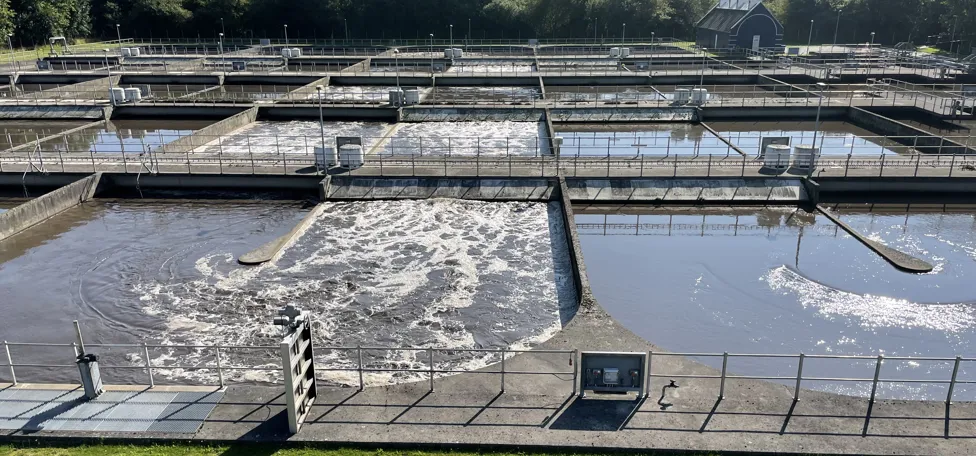- Services /
- Advanced wastewater treatment
Optimisation generates many benefits
Green energy, less sludge and a reduced carbon footprint are the results of using advanced wastewater treatment

Ejby Mølle in Odense is a state-of-the-art water resource recovery facility, with very high standards for wastewater treatment. One of our achievements from which the city benefits, is that our facility now produces more energy than it consumes. In 2018, the facility reached energy self-sufficiency of 180% – and we continue to push the limits for what is currently considered possible.
The very high energy production percentage is a result of years of continual optimisation of energy production coupled with relentless efforts to reduce energy consumption in the wastewater treatment processes. It was imperative that this work be carried out without compromising the quality of the wastewater treatment.
Experience and automation
Ejby Mølle is the main facility in the VCS Denmark portfolio. It is located in Odense, the third largest city in Denmark, and provides wastewater treatment to the people in the city and the suburbs of Odense. VCS Denmark has a long history that dates back to 1908. Since the very beginnings, owners and managers have ensured continuous development and upgrading of our facilities.
Anaerobic digesters were established in the 1950s to reduce the amounts of sludge, which is the waste product from the wastewater treatment processes. The digestion processes generate biogas, and eventually, VCS Denmark saw the potential for producing energy from this biogas.
The continued focus on improving existing methods, and the developing of new ones, has provided us with in-depth experience and insight into where it is possible to adjust and optimise the processes. We have obtained comprehensive hands-on experience and knowhow, and we are able to help other facilities in all areas, including: energy production or energy savings; reduction of emissions; resource recovery and wastewater treatment processes in general.
Automation and sensor technology are key in operating the facility, and active participation in domestic and international development projects ensures that we keep improving our methods and results and stay at the cutting edge of developments in our sector.
Wastewater is a resource
Wastewater largely consists of water and organic material. At VCS Denmark, this organic material is a resource that we must utilise in every way possible – e.g. as a resource for energy production. This is the mindset that has helped Ejby Mølle evolve from being a wastewater treatment plant (WWTP) to becoming a water resource recovery facility (WRRF).
As a part of the treatment process, organic material is separated from the wastewater. The sludge resulting from this process is pumped into digesters, where bacteria digest the organic material. The digestion process produces biogas that is utilised to produce electricity and heat.
Ejby Mølle is a net producer of energy, producing 180% of the energy that we consume (2018). This means increased revenue for the WRRF, as a considerable amount of energy can be sold and utilised as district heating and electricity.
Energy savings
A key element in reaching a self-sufficiency percentage of 180 is a persistent focus on energy savings.
A highly energy consuming process takes place in the aeration tank. The process requires both energy and the right bacteria in order to decompose ammonia to free nitrogen and to remove biological phosphorus. At VCS Denmark, smart sensors for online monitoring of the composition of the treated wastewater feed data to intelligent systems that ensure continuous adjusting and minimising of the oxygen consumption in the digestion process.
Another focus area in relation to energy optimisation is to ensure that the amount of carbon in the sludge that is processed in the digesters is a high as possible.
In the digesters, dry matter content is reduced – both as a result of the process itself, but also through recuperative dewatering of sludge for digestion optimisation. This reduces the amounts of residuals (i.e. biosolids) that ultimately have to be transported offsite. Biosolids are used as fertiliser on farmland.
Another energy saving focus point is the implementation of specialised treatment of reject water from the dewatering process. Reject water contains large amounts of ammonia. To efficiently remove ammonia, the reject water is sent through a side stream de-ammonification treatment process – where a specialised type of bacteria removes ammonia much more effectively than the bacteria in the aeration tank. The process is extremely efficient. However, constant focus is required in relation to emissions and striking the right balance, which is why VCS Denmark has conducted research in the managing of de-ammonification processes.
Surplus green energy
With a surplus of green energy being produced at Ejby Mølle, VCS Denmark is able to sell energy to local energy companies, while also reducing the city’s energy production based on non-renewable resources, e.g. coal, oil and natural gas. In this way, producing energy from sludge contributes to the reduction of undesirable emissions, and to a reduced carbon footprint.
If you wish to learn more and to make use of our expertise, please contact us and hear more about our consultancy services.